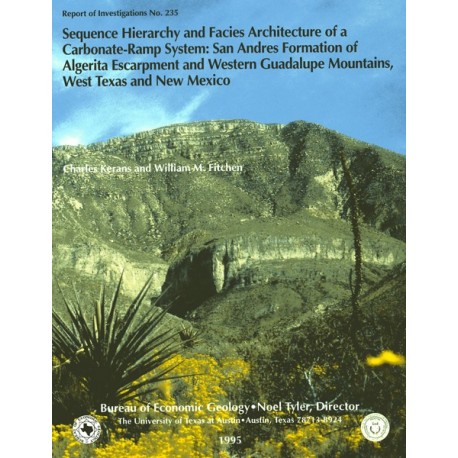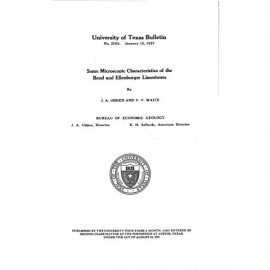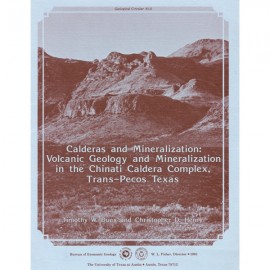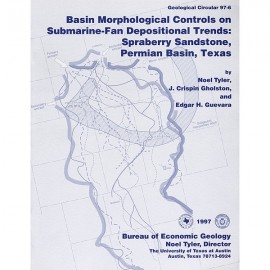Reports of Investigations
-
Books & Reports
- Reports of Investigations
- Guidebooks
- Udden Series
- Geological Circulars
- Down To Earth
- Atlases of Major Oil and Gas Reservoirs
- Texas Memorial Museum Publications
- Environmental Geologic Atlas of the Texas Coastal Zone
- Mineral Resource Circulars
- Other Reports
- Seminars and Workshops
- Handbooks
- Submerged Lands of Texas
- Symposia
- Annual Reports
- Open File Reports
-
Maps & Cross Sections
- Thematic Maps
- Miscellaneous Maps, Charts & Sections
- Geologic Atlas of Texas
- STATEMAP Project Maps
- Geologic Quadrangle Maps
- Cross Sections
- Highway Geology Map
- Energy and Mineral Resource Maps
- Shoreline Change and Other Posters
- Wilcox Group, East Texas, Geological / Hydrological Folios
- Bouguer Gravity Atlas of Texas
- River Basin Regional Studies
- Featured Maps
- Posters
- Teachers & the Public
-
Geological Society Publications
- Gulf Coast Association of Geological Societies
- Alabama Geological Society
- Austin Geological Society
- Corpus Christi Geological Society
- Houston Geological Society
- Lafayette Geological Society
- Mississippi Geological Society
- New Orleans Geological Society
- South Texas Geological Society
- GCS SEPM Publications
- Historic BEG & UT Series
Sequence Hierarchy and Facies Architecture of a Carbonate-Ramp System: San Andres Formation of ...Western Guadalupe Mtns
RI0235
For a downloadable, digital version: RI0235D.
RI0235. Sequence Hierarchy and Facies Architecture of a Carbonate-Ramp System: San Andres Formation of Algerita Escarpment and Western Guadalupe Mountains, West Texas and New Mexico, by Charles Kerans and W. M. Fitchen. 86 p., 55 figs., 2 tables, 2 color plates in pocket, 1995. Print.
To purchase this publication as a downloadable PDF, please order RI0235D.
About This Publication
This study offers a high-frequency sequence stratigraphic model of carbonate-ramp strata of the San Andres Formation. It also documents, at the cycle scale, the inner-ramp through outer-ramp portions of three high-frequency sequences and describes and maps carbonate facies within a high-frequency sequence framework.
ABSTRACT
The San Andres Formation (Leonardian-Guadalupian), as exposed along the Algerita Escarpment and in the Brokeoff Mountains, Cutoff Mountain, and the Western Escarpment of the Guadalupe Mountains, provides one of the world's most complete platform-to-basin transects of a carbonate-ramp system. More than 25,000 ft of measured sections and extensive bed tracing using oblique aerial photomosaics allowed construction of a detailed stratigraphic framework for the 22-mi dip-parallel exposures along this northwestern margin of the Delaware Basin. The hierarchy of stratigraphic cyclicity includes 2 composite sequences (long-term), 15 high-frequency sequences (HFS) (intermediate-term), and at least 100 high-frequency cycles (short-term) on the platform alone. This new high-resolution chronostratigraphic framework documents changes in the stratal architecture of a 2-m.y. period of carbonate ramp evolution. The report demonstrates the utility of a high-resolution chronostratigraphic framework in addressing hydrocarbon-exploration-scale problems and, equally important, places changing styles of reservoir-scale faciesarchitecture in a more inclusive and therefore more predictive stratigraphic framework.
Facies, vertical facies successions, and facies tracts are described within the context of this chronostratigraphic hierarchy, allowing detailed assessment of changing styles of depositional models through time. Nineteen facies are arranged in 11 vertical facies successions, along with several less repetitive facies successions. These facies successions are in turn grouped into facies tracts, which are strike-parallel belts of common depth- and energy-dependent sedimentation. Linkage of multiple facies tracts from a shelf-to-basin transect within highstand and transgressive systems tracts of individual high-frequency sequences allows development of depositional models specific to each high-frequency sequence.
This depositional analysis within a chronostratigraphic framework affords a better resolution of the evolution of the San Andres ramp. Major evolutionary stages include (1) a draping nonconstructional profile that mimics inherited topography (retrogradational sequence set of lower San Andres composite sequence; Leonardian 7 and 8 HFS), (2) constructional aggradational to strongly progradational carbonate ramp (progradational sequence set of lower San Andres composite sequence; Guadalupian 1-4 HFS), (3) a protracted phase of platform exposure and bypass of siliciclastic sediments to the basin center (lowstand sequence set, upper San Andres composite sequence, Guadalupian 5-11, Brushy Canyon Formation), (4) a ramp phase that is transitional into a rimmed shelf, with moderate to steep clinoform margin and locally developed bioherms (retrogradational sequence, upper San Andres composite sequence, Guadalupian 12 HFS), and (5) an oblique clinoform ramp with increasing biohermal boundstone at the margin (progradational sequence of upper San Andres composite sequence; Guadalupian 13 HFS San Andres and Cherry Canyon Tongue).
Comparison of the facies architecture of high-frequency cycles in transgressive versus highstand portions of a single HFS, and across multiple HFS (specifically the Guadalupian 2, 3, and 4 HFS), provides qualitative and quantitative information regarding the dynamics of platform depositional models associated with changes in accommodation both within and between high-frequency sequences. Comparison of the volume of ooid-peloid grainstone across 14 cycles in 3 high-frequency sequences shows a twofold increase in grainstones in highstand versus transgressive systems tracts. A plot of thickness versus depositional-dip-width of grainstone body geometry relative to stacking pattern within the Guadalupian 2-4 HFS demonstrates both accommodation-related and basin-setting-related controls of grainstone development. Similar analyses of reservoir facies architecture within a high-frequency sequence framework will be required to maximize our understanding of geologic reservoir frameworks for three-dimensional reservoir characterization.
Keywords: Algerita Escarpment, carbonate ramps, dolomite, Guadalupe Mountains, high-frequency sequence stratigraphy, New Mexico, oil reservoirs, San Andres Formation
CONTENTS
Abstract
Introduction
Regional Setting
San Andres Formation of the Guadalupe Mountains
San Andres Formation of the Algerita Escarpment and Brokeoff Mountains, Central Guadalupe Mountains
Methods and Data
Cyclic Stratigraphic and Chronostratigraphic Terminology
Cycles
High-Frequency Sequences (HFS)
Composite Sequences
Lithostratigraphic Terminology
Lithofacies
Vertical Facies Successions
Facies Tracts
Depositional Models
Distally Steepened Ramp-Leonardian 7 and 8 HFS, Retrogradational Sequence Set, Lower San Andres Composite Sequence
Facies and Vertical Facies Successions
Model Interpretation
Sigmoid Clinoform Progradational Ramp-Guadalupian 1-4 HFS, Progradational Sequence Set, Lower San Andres Composite Sequence
Facies and Vertical Facies Successions
Model Interpretation
Karst-Modified Eolian Bypass Surface-Guadalupian 5-11 HFS
(Brushy Canyon Formation), Lowstand Sequence Set, Upper San Andres Composite Sequence
Model Interpretation
Sigmoid Clinoform Ramp Transitional to Bioherm-Rimmed Shelf Depositional Model- Guadalupian 12 HFS, Retrogradational Sequence Set, Upper San Andres
Composite Sequence
Facies and Vertical Facies Successions
Model Interpretation
Sigmoid to Oblique Clinoform Ramp Depositional Model-Guadalupian 13 HFS
Progradational Sequence Set, Upper San Andres Composite Sequence
Facies and Vertical Facies Successions 3
Model Interpretation
San Andres High-Frequency Sequences
Leonardian 7 and 8 HFS (San Andres and Upper Victorio Peak Formations)
Guadalupian 1 HFS (San Andres and Cutoff Formations)
Guadalupian 2 HFS (San Andres and Cutoff Formations)
Guadalupian 3 HFS (San Andres and Cutoff Formations)
Guadalupian 4 HFS (San Andres and Cutoff Formations)
Guadalupian 5-1 1 HFS (Brushy Canyon Formation)
Guadalupian 12 HFS (San Andres and Uppermost Brushy Canyon Formations)
Guadalupian 13 HFS (San Andres and Lower Cherry Canyon Formations)
Systematic Changes at the High-Frequency Sequence Scale
Accommodation Trends
Trends in Facies-Tract Volume, Aspect Ratio, and Facies Composition and Diversity
Sequence Boundaries
Cycle-Scale Stratigraphic Architecture within a High-Frequency Sequence Framework
Cycle as Basic Reservoir-Scale Element
Cycle Models within the HFS Framework
Two-Dimensional Analysis of Cycles
Cycle 7: Cycle Development at High-Frequency Sequence-Scale Maximum Flooding
Cycle 1: Progradational Cycle Set Example, Guadalupian 2 HFS
Cycle 9: Uppermost Progradational Cycle, Guadalupian 3 HFS
Cycle 5: Retrogradational Cycle, Guadalupian 3 HFS
High-Frequency Sequence-Specific Depositional Models for Predicting Facies Architecture: Ramp Crest of G2-3 vs. G4 HFS
Depositional Models for Predicting Facies Architecture: Retrogradational and Progradational Cycles-Guadalupian 2 and 3 HFS
Two-Dimensional Architecture of Inner-Ramp through Outer-Ramp Transition in Guadalupian 3 HFS
Conclusions
Acknowledgments
References
Figures
1. Regional paleogeography of the Permian Basin showing location of San Andres reservoirs that have produced more than 10 MMbbl of oil
2. Stratigraphic nomenclature of uppermost Leonardian through Guadalupian units of the Permian Basin
3. Setting of the Permian Basin and San Andres platforms relative to North American Guadalupian paleogeography
4. Geologic map of Guadalupe Mountains area showing location of the Buckthorn and Algerita Escarpments, Brokeoff Mountains, and Western Escarpment and general outcrop pattern of San Andres Formation
5. Thematic mapper image of western Guadalupe Mountains showing physiographic features and location of regional measured section data
6. Generalized stratigraphic model of upper Leonardian through upper Guadalupian high-frequency sequences in the Guadalupe Mountains and Delaware Basin, Texas and New Mexico
7. Generalized evolution of latest Leonardian through Guadalupian platform-to-basin transitions
8. Chronostratigraphic relationships of high-frequency sequence framework of San Andres Formation and related units in type section, Guadalupe Mountains and subsurface of Delaware Basin and Central Basin Platform
9. Relationship of lithostratigraphic terms in framework of composite and high-frequency sequences
10. Measured section showing high-frequency sequence and cycle framework, San Andres Formation at Lawyer Canyon
11. Oblique aerial photograph of San Andres and Yeso Formations, Algerita Escarpment, Lawyer Canyon area, showing sequence contacts and location of the Lawyer Canyon ramp-crest window study area
12. Sequence stratigraphic terminology of stratigraphic hierarchies used in this report
13. Relationship between time-stratigraphic and rock-stratigraphic terms used in this study
14. Facies-tract distribution within framework of depositional and high-frequency sequences of the San Andres Formation and basinal equivalents
15. Facies in VFS successions 1-3, Leonardian 7 and 8 HFS
16. Vertical facies successions 1-4, showing general facies characteristics, interpreted depositional environment, and stratigraphic occurrence
17. Regional measured section data, Leonardian 7 and 8 HFS
18. Facies-tract distribution, Leonardian 7 and 8 HFS
19. Depositional model, Leonardian 7 and 8 HFS, showing flat-topped subtidal platform with localized ramp-crest shoals
20. Typical measured section of fusulinid wackestone-packstone cycles of type 6,Lawyer Canyon area
21. Field and thin-section views of Guadalupian 2 and 3 facies and cycles
22. Guadalupian 1-4 facies
23. Vertical facies successions 5-1 0, Guadalupian high-frequency sequences
24. Karst sinkhole at top of Guadalupian 3 HFS, section V, Lawyer Canyon area
25. Facies-tract distribution and karst-modified sequence boundaries, Guadalupian 1-4 HFS
26. Depositional model, Guadalupian 1-4 sigmoid progradational ramp system
27. Depositional model, Guadalupian 5-11 HFS
28. Wavy-laminated siltstone facies from Guadalupian 13 HFS
29. Facies-tract distribution now recognized for Guadalupian 12 and 13 HFS
30. Transitional sigmoid clinoform ramp to bioherm-rimmed depositional model, Guadalupian 12 HFS
31. Sigmoid-to-oblique clinoform ramp depositional model, Guadalupian 13 HFS
32. View of uppermost Yeso Formation and basal Leonardian 7 HFS in the HB area, West Dog Canyon
33. Victorio Peak and Cutoff Formation section at Cutoff Mountain including Leonardian 6-8 and Guadalupian 1 HFS
34. Oblique aerial photograph of the Algerita Canyon area of Algerita Escarpment, showing the turnaround from retrogradational to progradational high-frequency sequences
35. View of west wall of West Dog Canyon showing terminal ramp margin of Guadalupian 4 HFS
36. Oblique aerial view of upper 500 ft of San Andres Formation at North Brister Tank
37. Simplified sketch and interpreted photograph of north wall of lrabarne Tank Canyon
38. Sequence relationships and stacking patterns in the lrabarne Tank Canyon section
39. Oblique aerial view of Leonardian 8-Guadalupian 15 HFS, Cutoff Ridge, western Brokeoff Mountains
40. View of west wall of West Dog Canyon showing terminal ramp margin of the Guadalupian 12 HFS and the overlying Guadalupian 13 HFS
41. Stratal truncation at top of San Andres Formation (top Guadalupian 13 HFS) as seen at lrabarne Tank Canyon section
42. Location of position of maximum accumulation within each high-frequency sequence
43. Histogram showing the volume of ramp-crest facies tract as a percentage of total HFS and thickness-dip-width ratio versus HFS
44. Spatial portrayal of criteria used to define high-frequency sequence boundaries of Leonardian 7-Guadalupian 13 HFS along Algerita Escarpment
45. Generalized stratigraphic framework of the Lawyer Canyon window area, including cycles, high-frequency sequences, and key facies
46. Facies architecture and depositional history of cycle 7
47. Outcrop characteristics of cycle 7
48. Facies architecture of cycle 1, progradational cycle set of Guadalupian 2 HFS
49. Facies architecture of cycle 9, uppermost cycle in Guadalupian HFS 3
50. Facies architecture of cycle 5, a retrogradational cycle within Guadalupian 3 HFS
51. Stratigraphic setting of ramp-crest facies tracts within Guadalupian 2, 3, and 4 HFS and position of these HFS within the progradational sequence set of the lower San Andres composite sequence
52. Simplified cross section of combined Lawyer-Algerita, Lawyer, and Lawyer-Fenceline windows
53. Dynamic character of facies, facies tracts, and depositional models in context of a high-frequency sequence setting
54. Stratal pattern versus depositional model, Guadalupian grainstone complexes
55. Analysis of facies geometry and proportion within a sequence framework
Tables
1. Facies descriptions, Leonardian 7 and 8 and Guadalupian HFS
2. Facies descriptions, Guadalupian 2-13 HFS
Plates
1. Sequence stratigraphic framework of the San Andres Formation, Algerita Escarpment to Brokeoff Mountains, southeast New Mexico
2. Facies and cycle architecture of Guadalupian 2, 3, and 4 HFS in ramp-crest setting
Citation
Kerans, Charles, and Fitchen, W. M., 1995, Sequence Hierarchy and Facies Architecture of a Carbonate-Ramp System: San Andres Formation of Algerita Escarpment and Western Guadalupe Mountains, West Texas and New Mexico: The University of Texas at Austin, Bureau of Economic Geology, Report of Investigations No. 235, 86 p.






